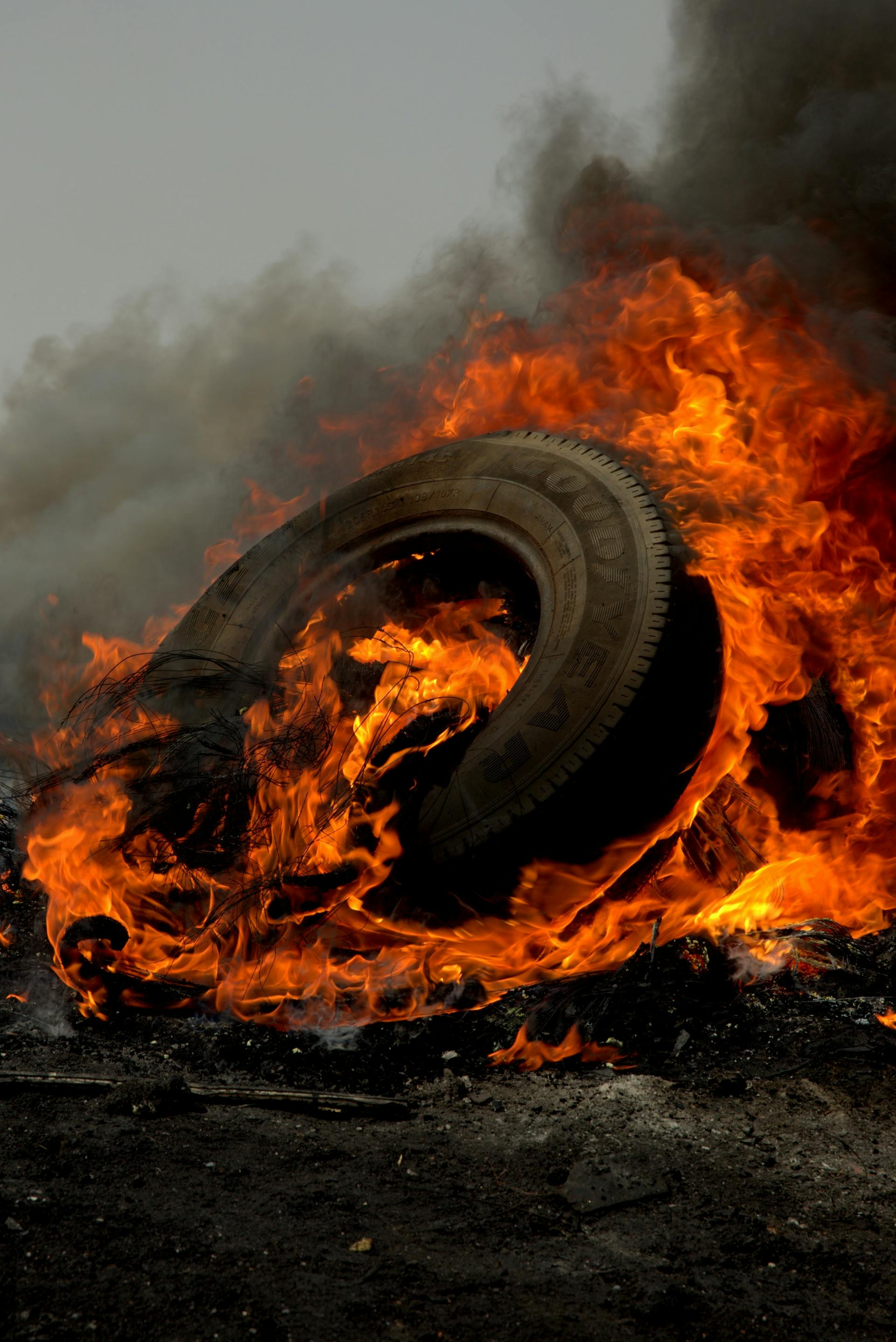
Environmental Story
Why our products offer a better option for end of life tyres
Did you know that used car tyres are the third largest source of waste in the world? The disposal of 1.5 billion waste tyres annually presents a significant global challenge. While some tyres can be retreaded and reused, this is not a solution. Once tyres reach the end of their useful life, their complex composition makes recycling difficult. They consist of a mixture of materials including natural and synthetic rubber, fibres, and wire, all contained within a heavy and cumbersome package. More so, tyres do not biodegrade naturally, leading to a growing accumulation each year. Addressing this challenge requires innovative approaches to tyre disposal and recycling to mitigate environmental impacts and manage this ever-increasing waste stream effectively (Williams, 2017).
Landfilling end-of-life tyres (ELTs) is both the easiest and most detrimental disposal option. When tyres are disposed of in landfills, they release toxins into the soil and water, posing significant environmental risks. In tropical regions, they collect water, creating breeding grounds for disease-carrying mosquitoes, thus posing a serious health hazard. Even in arid environments like deserts, landfilling tyres remains hazardous. Tyre dumps are prone to fires, which are notoriously difficult to extinguish. For instance, a valley containing 10 million tyres caught fire near Knighton, Wales, in 1989, taking months to extinguish and smouldering until 2004—a staggering 15 years of ongoing hazard and environmental damage (Williams, 2017).
In Kuwait City's Sulaibiya area, massive pits are annually excavated in the sandy terrain to serve as dumping grounds for old tyres, accumulating to over seven million tyres buried in the ground. The sheer expanse of rubber is so immense that the substantial indentations on the earth's surface are now observable from space. However, this practice poses significant risks. On April 29, 2021, a fire erupted in one of Kuwait's tyre dumps, its scale so extensive that it was visible from space. Tyre fires present formidable challenges for extinguishment, as they emit copious amounts of smoke carrying toxic chemicals from the breakdown of rubber compounds during combustion. This incident underscores the environmental and public health hazards associated with improper tyre disposal methods and the urgency for sustainable waste management practices (Daily Mail, 2013).
Thus, landfilling end-of-life tyres (ELTs) is clearly an undesirable option as it not only results in the loss of valuable materials and energy but also poses significant environmental and health risks. However, incinerating tyres for energy recovery presents a potential solution. In fact, this approach, known as energy recovery, accounts for approximately half of Europe's tyre disposal methods. Although, burning tyres is widely recognised as an unsustainable and potentially hazardous method of waste disposal. As it poses significant environmental risks and can have adverse effects on public health (Donnelly, 2023).
With the European Union's ban on sending tyres to landfill, there has been a surge in research and development aimed at finding innovative ways to reuse tyre materials. This shift has led to the emergence of numerous businesses that view end-of-life tyres as valuable resources rather than waste. Among the various reuse options, one of the more prevalent applications is the creation of rubberised surfaces used in playgrounds and running tracks. These surfaces not only provide a sustainable solution for disposing of tyres but also offer benefits such as durability, shock absorption, and safety for users. This example highlights the potential for transforming waste tyres into valuable products that contribute to a circular economy while addressing environmental concerns (Williams, 2017).
Recent government data on rubber exports reveals that a significant portion, 75%, of end-of-life tyre (ELT) waste tyre exports from the UK ultimately end up in the Indian subcontinent. Unfortunately, much of this exported volume is managed in a highly polluting manner, exacerbating environmental and health concerns. Indian authorities are grappling with the rampant illegal distribution of ELT waste tyres for vehicle use and the hazardous practice of clandestine pyrolysis operations. Workers in these unregulated and often illegal pyrolysis plants face dire conditions, with their life expectancy estimated at only seven years due to the noxious by-products emitted during tyre burning. This alarming situation underscores the urgent need for improved waste management practices and international cooperation to address the global challenges posed by end-of-life tyre disposal. (Tyre Recovery Association, 2024).
“Every month, thousands of tonnes of used tyres leave our ports on a passage to India. There they are baked in pyrolysis plants, to make a dirty industrial fuel. While some of these plants meet Indian regulations, hundreds – perhaps thousands – are pouring toxins into the air, as officials look the other way. When tyre pyrolysis is done badly, it can produce a hideous mix: heavy metals, benzene, dioxins, furans and other persistent organic chemicals, some of which are highly carcinogenic. Videos of tyre pyrolysis in India show black smoke leaking from the baking chamber, and workers in T-shirts, without masks or other protective equipment, cleaning tarry residues out of the pipes and flasks. I can only imagine what their life expectancy might be. India suffers one of the world’s worst pollution crises, which causes massive rates of disease and early death. There is no data on the contribution made by tyre pyrolysis plants, but it is doubtless significant.” (Monbiot, 2019).
The Tyre Recovery Association (TRA) has raised concerns that surplus tyres in the UK may face illegal disposal methods such as fly-tipping or burning due to challenges in exporting to India caused by attacks on shipping in the Red Sea. The TRA highlighted that prices paid in India have plummeted significantly as transport costs rise due to attacks by Yemen's Houthi militia, forcing ships to take longer and costlier routes around the Cape of Good Hope (Smulian, 2024).
Under normal circumstances, 75% of UK waste tyres are exported to India via the Red Sea route. However, with this route becoming economically unfeasible, unscrupulous tyre collectors, deprived of the Indian market, may resort to illegal practices instead of engaging with regulated TRA members. The TRA noted that collectors operating at the lower end of the market heavily rely on Indian exports, and with prices collapsing, there is a risk of increased fly-tipping, abandonment, and tyre fires, as observed during previous price collapses. This situation underscores the need for proactive measures to address the challenges faced by the tyre recycling industry and prevent environmental and safety hazards associated with illegal tyre disposal (Smulian, 2024).
References
Kieran Donnelly, 12 June 2023, Gradual International Ltd, accessed 23 February 2024, <https://gradeall.com/risks-of-burning-tyres-and-tyres-recycling-alternatives/>.
Jeremy Williams, 29 June 2017, The Earthbound Report, accessed 23 February 2024, <https://earthbound.report/2017/06/29/what-can-the-world-do-with-1-5-billion-waste-tyres/>.
Daily Mail Reporter, 7 June 2013, Daily Mail Online, accessed 23 February 2024, <https://www.dailymail.co.uk/news/article-2337351/Worlds-biggest-tyre-graveyard-Incredible-images-Kuwaiti-landfill-site-huge-seen-space.html>.
Dominic Potts, 7 July 2022, Smart Resources Recycling, accessed 23 February 2024, <https://smart-rr.co.uk/the-pros-and-cons-of-burning-tire-derived-fuel-as-a-green-energy-alternative/>.
George Monbiot, 30 January 2019, The Guardian, accessed 23 February 2024, <https://www.theguardian.com/commentisfree/2019/jan/30/worse-than-plastic-burning-tyres-india-george-monbiot>.
Red Sea warning – time to stop export of UK carbon footprint – TRA calls on UK government to do the right thing, support British operators and end polluting export of end-of-life tyres, 30 January 2024, Tyre Recovery Association, accessed 23 February 2024, <https://tyrerecovery.org.uk/2024/01/30/red-sea-warning-time-to-stop-export-of-uk-carbon-footprint-tra-calls-on-uk-government-to-do-the-right-thing-support-british-operators-and-end-polluting-export-of-end-of-life-tyres/#:~:text=local%20tyre%20collector%3A-,Red%20Sea%20warning%20%E2%80%93%20time%20to%20stop%20export%20of%20UK%20carbon,of%20end%2Dof%2Dlife%20tyres>.
Mark Smulian, 8 September 2023, Materials Recycling World, accessed 23 February 2024, <https://www.mrw.co.uk/news/defra-urged-to-halt-whole-end-of-life-tyre-exports-08-09-2023/#:~:text=The%20Government%20must%20act%20to,avoid%20environmentally%20damaging%20treatments%20abroad.>
Mark Smulian, 13 February 2024, Materials Recycling World, accessed 23 February 2024, <https://www.mrw.co.uk/news/tyre-recyclers-urge-reform-as-india-exports-uneconomic-13-02-2024/#:~:text=Surplus%20tyres%20could%20be%20fly,Association%20(TRA)%20has%20warned.>
